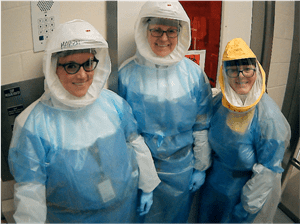Researchers in the Department of Orthopaedic Surgery at Indiana University School of Medicine discovered that mouse models infected with the novel coronavirus lost approximately 25% of their bone mass within two weeks of contagion. They also found mouse models with a 63% increase in osteoclasts, the cells that cause bone to break down.
These changes were observed even in mice with mild and asymptomatic infections.
The study is part of ongoing coronavirus-related research being conducted by the Kacena Lab in Indianapolis, led by Melissa Kacena, PhD, the Vice Chair of Research for the Department of Orthopaedic Surgery. Findings will be published in the medical journal BONE.
The study raises questions about the lasting implications of the pandemic and the virus’s effects on the musculoskeletal system. The discovery will likely inspire further research into the potential bone loss experienced by people of all ages who contract COVID-19.
Decreased bone mass, or osteoporosis, can lead to brittle bones that are prone to breaks.
Elderly people have always been the most at-risk group for complications due to osteoporosis, because they are least likely to naturally regenerate lost bone matter. Because the elderly are also at a higher risk of contracting COVID-19, Kacena is studying if those who overcome the virus will now be even more likely to suffer broken bones.
And with more children contracting the Delta variant, further questions are raised about whether young people can develop adequate bones after contracting the virus. Humans don’t reach peak bone mass until about age 25, Kacena said, and COVID-19 could be impacting normal bone development.
Kacena diverted her work to SARS-CoV-2 after several studies from across the country revealed that those dying from the coronavirus had high numbers of megakaryocytes built up in various organs, which causes significant issues.
Megakaryocytes are among Kacena’s areas of expertise; she studies their relation to bone regeneration and fracture healing.
The Kacena Lab began using transgenic mouse models to further study the coronavirus and its relation to megakaryocytes and bone health. It was the first lab in Indiana and only one of a handful of labs in the United States to start conducting coronavirus-related experiments at this level.
Megakaryocytes are large bone marrow cells that produce platelets needed for blood clotting. The autopsies of those who died from COVID-19 have revealed significant megakaryocyte build-ups in the heart, lungs and brain. The lab’s goal was to discover whether regulating megakaryocytes could change the severity of COVID-19 and decrease its morbidity and mortality.
From there, Kacena’s researchers began questioning the other effects COVID-19 might be having on the body, particularly the musculoskeletal system. These inquiries ultimately led to the discovery of decreased bone matter in the coronavirus-infected mice.
Researchers found a 24.4% decrease in trabecular bone volume fraction; a 19.0% decrease in trabecular number; a 6.2% decrease in trabecular thickness; and a 9.8% increase in trabecular separation.

Researchers at all levels assist with work done in the Kacena Lab.
The lead author on the study published in BONE is Olatundun Awosanya, who began working in the Kacena Lab as an undergraduate in 2018 when she was assigned to work in the lab after being accepted into IUPUI’s Life-Health Science Internship (LHSI) program.
LHSI places 75 undergraduate students in immersive experiences around the Indianapolis campus, encouraging them to explore career goals while gaining important professional skills.
In her senior year at IUPUI, Awosanya was named College Intern of the Year by the Indiana Chamber of Commerce for her work in the Kacena Lab. Now, Awosanya is working toward a doctoral degree under Kacena’s mentorship.
The work was made possible by grant funding from the Cooperative Center of Excellence in Hematology (CCEH) at IU School of Medicine and the Indiana Clinical and Translational Sciences Institute (CTSI).
This work was also supported in part by VA Merit Review Award #BX003751 from the United States (U.S.) Department of Veterans Affairs Rehabilitation Research and Development Service. The contents do not represent the views of the U.S. Department of Veterans Affairs, the National Institutes of Health, or the United States Government.
